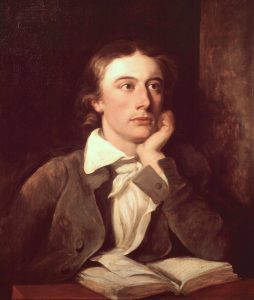66 Biography: John Keats

Portrait of John Keats
Artist | William Hilton Source | Wikimedia Commons License | Public Domain
(1795-1821)
John Keats, like Blake, was trained in a profession. He studied to be a surgeon and was expected to earn his own living. His mother Frances Jennings was from the landed gentry; his father Thomas Keats was a livery stable-keeper. Because his society consequently placed him within the labor class, Keats’s decision to write poetry, a “genteel” art, was in itself a radical act.
Keats’ first published poems received harsh criticism, to some extent sharpened by Keats’ association with Hunt and by Keats’ lower class status. The conjunction of these criticisms and Keats’s death at the age of twenty-five led some contemporaries to believe that Keats died of a broken heart. This belief connected with some views of Keats’ poetry as sensual and emotional without intellectual heft. Keats’ letters, though, published after his death, demonstrate his extraordinary conceptual thinking, about poetry’s role in society and about what makes a poem or poet great.
His theory of Negative Capability in particular fleshes out his ideas on the imagination. Negative Capability is sustained potentiality; it allows all possibilities to exist at once in the imagination together without the poet reaching towards one and thus eliminating all of the others. Through Negative Capability, the poet sees both the world of color, or the rainbow world, and the world in black and white; sees both the glittery surface of the ocean and the menacing whales beneath; sees both the delightful, delicate sparrow and the worm-ravening beast. Through Negative Capability, the poet doesn’t reach after fact or reason but allows all things—new stars, flowers bred by the fancy—to be. The completion of an experience is the negative capability, the not reaching after. For Keats, the poet sustains intensity and detachment, poise, suspension.
To learn medicine, Keats worked as a dresser, that is, the person who cleans up after the surgeons’ bloody work. He was apprenticed to a surgeon named Hammond—sometimes called “Butcher” Hammond—for five years, but stayed with him three and a half years. Keats then studied with well-known doctors, particularly Astley Cooper, who mentored Keats. After a year more of study, Keats began to doubt his abilities and interest in medicine. He took an apothecary license, but, with six months of study remaining for him to license as a surgeon, Keats left medicine for poetry.
This material is from British Literature II: Romantic Era to the Twentieth Century and Beyond by Bonnie J. Robinson from the University System of Georgia, which is licensed under a Creative Commons Attribution-ShareAlike 4.0 International License.
This license allows you to remix, tweak, and build upon this work, even commercially, as long as you credit this original source for the creation and license the new creation under identical terms.
